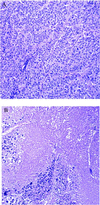Targeting tumor vasculature endothelial cells and tumor cells for immunotherapy of human melanoma in a mouse xenograft model
- PMID: 10393965
- PMCID: PMC22205
- DOI: 10.1073/pnas.96.14.8161
Targeting tumor vasculature endothelial cells and tumor cells for immunotherapy of human melanoma in a mouse xenograft model
Abstract
An immunotherapy treatment for cancer that targets both the tumor vasculature and tumor cells has shown promising results in a severe combined immunodeficient mouse xenograft model of human melanoma. The treatment involves systemic delivery of an immunoconjugate molecule composed of a tumor-targeting domain conjugated to the Fc effector domain of human IgG1. The effector domain induces a cytolytic immune response against the targeted cells by natural killer cells and complement. Two types of targeting domains were used. One targeting domain is a human single-chain Fv molecule that binds to a chondroitin sulfate proteoglycan expressed on the surface of most human melanoma cells. Another targeting domain is factor VII (fVII), a zymogen that binds with high specificity and affinity to the transmembrane receptor tissue factor (TF) to initiate the blood coagulation cascade. TF is expressed by endothelial cells lining the tumor vasculature but not the normal vasculature, and also by many types of tumor cells including melanoma. Because the binding of a fVII immunoconjugate to TF might cause disseminated intravascular coagulation, the active site of fVII was mutated to inhibit coagulation without affecting the affinity for TF. The immunoconjugates were encoded as secreted molecules in a replication-defective adenovirus vector, which was injected into the tail vein of severe combined immunodeficient mice. The results demonstrate that a mutated fVII immunoconjugate, administered separately or together with a single-chain Fv immunoconjugate that binds to the tumor cells, can inhibit the growth or cause regression of an established human tumor xenograft. This procedure could be effective in treating a broad spectrum of human solid tumors that express TF on vascular endothelial cells and tumor cells.
Figures









References
Publication types
MeSH terms
Substances
Grants and funding
LinkOut - more resources
Full Text Sources
Other Literature Sources
Medical
Miscellaneous

